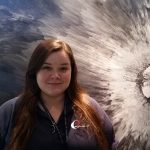celebrating the 50th anniversary of apollo 11
On 20 July 1969, the first humans to set foot on the surface of the Moon drove forward a legacy of science, innovation, and discovery. The knowledge gained from samples collected on Apollo missions and continued studies of the Moon and its relationship to Earth and other bodies in and beyond our solar system is invaluable.
AGU-National Archives Foundation Public Panel Event
In honor of Apollo 11’s 50th anniversary and as part of the AGU’s Centennial celebration, AGU partnered with the National Archives Foundation to host a panel discussion moderated by NASA’s chief scientist Jim Green with panelists Sean Solomon, director of the Lamont-Doherty Earth Observatory, Sonia Tikoo, assistant professor of geophysics at Stanford University, Steven Hauck, professor of planetary geodynamics at Case Western Reserve University and Heather Meyer, postdoctoral fellow at the Lunar and Planetary Institute.
A conversation with the AGU, including opening remarks from Executive Director and CEO Christine McEntee and President Robin Bell
PANELIST BIOGRAPHIES
Jim Green (Moderator)
Chief scientist, NASA
Jim Green is NASA’s chief scientist. From 2006 to 2018, Jim was the director of the Planetary Science Division at NASA Headquarters. Under his leadership several missions have been successfully executed, including the New Horizons spacecraft flyby of Pluto, the MESSENGER spacecraft to Mercury, the Juno spacecraft to Jupiter, the Grail A and B spacecraft to the Moon, the Dawn spacecraft to Vesta and Ceres, and the landing of the Curiosity rover on Mars.
Jim began working in the Magnetospheric Physics Branch at NASA’s Marshall Space Flight Center (MSFC) in 1980. At Marshall, Jim developed and managed the Space Physics Analysis Network, which provided many scientists, all over the world, with rapid access to data, other scientists, and specific NASA computer and information resources. In addition, Jim was a safety diver in the neutral buoyancy tank making over 150 dives until he left MSFC in 1985. Jim received his PhD in space physics from the University of Iowa in 1979.
 Sean Solomon
Sean Solomon
Director of Lamont-Doherty Earth Observatory
Sean Solomon is the director of the Lamont-Doherty Earth Observatory at Columbia University. Prior to this role, Sean served for 19 years as director of the Carnegie Institution’s Department of Terrestrial Magnetism in Washington, D.C., and for 20 years before that as a Professor of Geophysics at the Massachusetts Institute of Technology, where he earlier received his Ph.D. Sean was the principal investigator for NASA’s MESSENGER mission to Mercury and co-investigator on missions to Venus, Mars, and the Moon. He is a member of the National Academy of Sciences and the American Academy of Arts and Sciences and served as President of the American Geophysical Union in 1996-98. In 2014 he received the National Medal of Science from President Barack Obama.
 Sonia Tikoo
Sonia Tikoo
Assistant professor of geophysics at Stanford University
Sonia Tikoo is an assistant professor of geophysics at Stanford University. Her research focuses on lunar paleomagnetism, which involves measuring the magnetism recorded in Apollo samples to determine the paleointensity evolution and the origin of the Moon’s ancient magnetic field. She also studies the physical effects of impact cratering events on planetary surfaces. Sonia earned her Ph.D. in planetary science from the Massachusetts Institute of Technology.
 Steven Hauck
Steven Hauck
Professor and Chair of Earth, Environmental, and Planetary Sciences at Case Western Reserve University
Steven Hauck studies the evolution of interiors and surfaces of terrestrial and icy bodies. He analyses data returned from spacecraft missions the Moon, Mercury, Venus, and Mars to characterize their interiors. This research also includes numerical modeling of how planets cool, how lithospheres deform, and how their metallic cores crystallize. He was a Participating Scientist on NASA’s MESSENGER mission and recently completed a term as the Editor-in-Chief of the Journal of Geophysical Research: Planets. Steven earned his PhD from Washington University in St. Louis.
 Heather Meyer
Heather Meyer
Postdoctoral fellow at the Lunar and Planetary Institute
Heather Meyer’s research interests encompass the formation and degradation of planetary surfaces, particularly regarding impact cratering, tectonics and volcanic processes of Mars, Mercury, Europa, and the Moon. Her current research focuses primarily on the formation of large lunar impact basins and their associated deposits. With the Lunar Reconnaissance Orbiter Camera (LROC) Science Team, she integrates available remote sensing data sets to derive insights into the formation and emplacement mechanisms behind impact features such as light plains, impact melt, and ejecta. She earned her PhD in geological sciences from the School of Earth and Space Exploration at Arizona State University studying large impact basins on the Moon.


